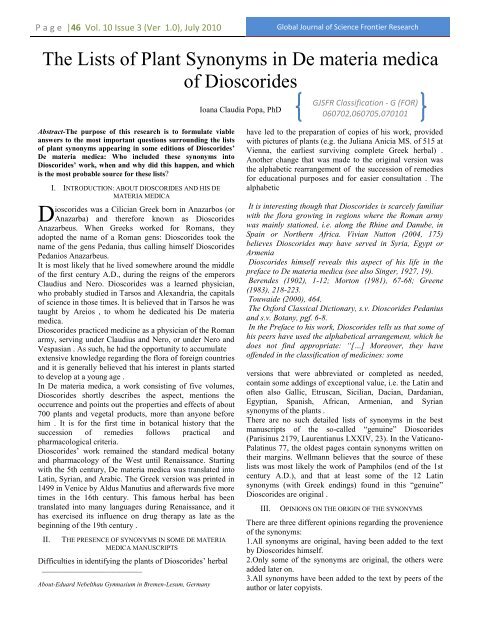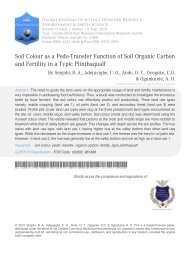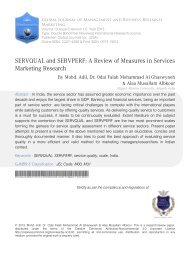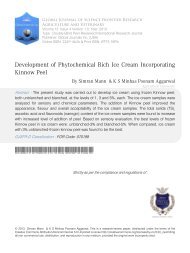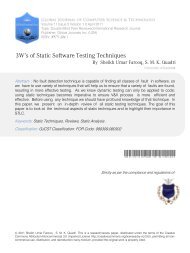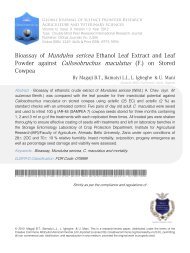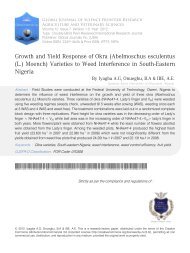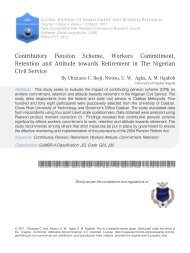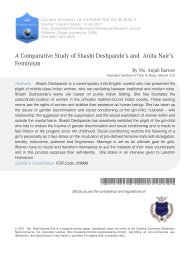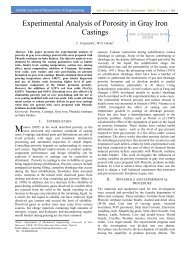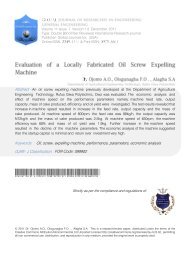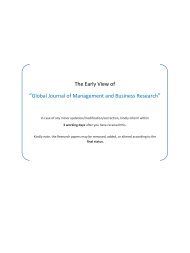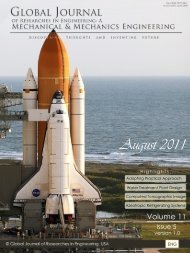The Lists of Plant Synonyms in De materia
The Lists of Plant Synonyms in De materia
The Lists of Plant Synonyms in De materia
You also want an ePaper? Increase the reach of your titles
YUMPU automatically turns print PDFs into web optimized ePapers that Google loves.
P a g e |46 Vol. 10 Issue 3 (Ver 1.0), July 2010<br />
Global Journal <strong>of</strong> Science Frontier Research<br />
<strong>The</strong> <strong>Lists</strong> <strong>of</strong> <strong>Plant</strong> <strong>Synonyms</strong> <strong>in</strong> <strong>De</strong> <strong>materia</strong> medica<br />
<strong>of</strong> Dioscorides<br />
Abstract-<strong>The</strong> purpose <strong>of</strong> this research is to formulate viable<br />
answers to the most important questions surround<strong>in</strong>g the lists<br />
<strong>of</strong> plant synonyms appear<strong>in</strong>g <strong>in</strong> some editions <strong>of</strong> Dioscorides’<br />
<strong>De</strong> <strong>materia</strong> medica: Who <strong>in</strong>cluded these synonyms <strong>in</strong>to<br />
Dioscorides’ work, when and why did this happen, and which<br />
is the most probable source for these lists?<br />
D<br />
I. INTRODUCTION: ABOUT DIOSCORIDES AND HIS DE<br />
MATERIA MEDICA<br />
ioscorides was a Cilician Greek born <strong>in</strong> Anazarbos (or<br />
Anazarba) and therefore known as Dioscorides<br />
Anazarbeus. When Greeks worked for Romans, they<br />
adopted the name <strong>of</strong> a Roman gens: Dioscorides took the<br />
name <strong>of</strong> the gens Pedania, thus call<strong>in</strong>g himself Dioscorides<br />
Pedanios Anazarbeus.<br />
It is most likely that he lived somewhere around the middle<br />
<strong>of</strong> the first century A.D., dur<strong>in</strong>g the reigns <strong>of</strong> the emperors<br />
Claudius and Nero. Dioscorides was a learned physician,<br />
who probably studied <strong>in</strong> Tarsos and Alexandria, the capitals<br />
<strong>of</strong> science <strong>in</strong> those times. It is believed that <strong>in</strong> Tarsos he was<br />
taught by Areios , to whom he dedicated his <strong>De</strong> <strong>materia</strong><br />
medica.<br />
Dioscorides practiced medic<strong>in</strong>e as a physician <strong>of</strong> the Roman<br />
army, serv<strong>in</strong>g under Claudius and Nero, or under Nero and<br />
Vespasian . As such, he had the opportunity to accumulate<br />
extensive knowledge regard<strong>in</strong>g the flora <strong>of</strong> foreign countries<br />
and it is generally believed that his <strong>in</strong>terest <strong>in</strong> plants started<br />
to develop at a young age .<br />
In <strong>De</strong> <strong>materia</strong> medica, a work consist<strong>in</strong>g <strong>of</strong> five volumes,<br />
Dioscorides shortly describes the aspect, mentions the<br />
occurrence and po<strong>in</strong>ts out the properties and effects <strong>of</strong> about<br />
700 plants and vegetal products, more than anyone before<br />
him . It is for the first time <strong>in</strong> botanical history that the<br />
succession <strong>of</strong> remedies follows practical and<br />
pharmacological criteria.<br />
Dioscorides‘ work rema<strong>in</strong>ed the standard medical botany<br />
and pharmacology <strong>of</strong> the West until Renaissance. Start<strong>in</strong>g<br />
with the 5th century, <strong>De</strong> <strong>materia</strong> medica was translated <strong>in</strong>to<br />
Lat<strong>in</strong>, Syrian, and Arabic. <strong>The</strong> Greek version was pr<strong>in</strong>ted <strong>in</strong><br />
1499 <strong>in</strong> Venice by Aldus Manutius and afterwards five more<br />
times <strong>in</strong> the 16th century. This famous herbal has been<br />
translated <strong>in</strong>to many languages dur<strong>in</strong>g Renaissance, and it<br />
has exercised its <strong>in</strong>fluence on drug therapy as late as the<br />
beg<strong>in</strong>n<strong>in</strong>g <strong>of</strong> the 19th century .<br />
II. THE PRESENCE OF SYNONYMS IN SOME DE MATERIA<br />
MEDICA MANUSCRIPTS<br />
Difficulties <strong>in</strong> identify<strong>in</strong>g the plants <strong>of</strong> Dioscorides‘ herbal<br />
_______________________________<br />
About-Eduard Nebelthau Gymnasium <strong>in</strong> Bremen-Lesum, Germany<br />
Ioana Claudia Popa, PhD<br />
GJSFR Classification - G (FOR)<br />
060702,060705,070101<br />
have led to the preparation <strong>of</strong> copies <strong>of</strong> his work, provided<br />
with pictures <strong>of</strong> plants (e.g. the Juliana Anicia MS. <strong>of</strong> 515 at<br />
Vienna, the earliest surviv<strong>in</strong>g complete Greek herbal) .<br />
Another change that was made to the orig<strong>in</strong>al version was<br />
the alphabetic rearrangement <strong>of</strong> the succession <strong>of</strong> remedies<br />
for educational purposes and for easier consultation . <strong>The</strong><br />
alphabetic<br />
It is <strong>in</strong>terest<strong>in</strong>g though that Dioscorides is scarcely familiar<br />
with the flora grow<strong>in</strong>g <strong>in</strong> regions where the Roman army<br />
was ma<strong>in</strong>ly stationed, i.e. along the Rh<strong>in</strong>e and Danube, <strong>in</strong><br />
Spa<strong>in</strong> or Northern Africa. Vivian Nutton (2004, 175)<br />
believes Dioscorides may have served <strong>in</strong> Syria, Egypt or<br />
Armenia<br />
Dioscorides himself reveals this aspect <strong>of</strong> his life <strong>in</strong> the<br />
preface to <strong>De</strong> <strong>materia</strong> medica (see also S<strong>in</strong>ger, 1927, 19).<br />
Berendes (1902), 1-12; Morton (1981), 67-68; Greene<br />
(1983), 218-223.<br />
Touwaide (2000), 464.<br />
<strong>The</strong> Oxford Classical Dictionary, s.v. Dioscorides Pedanius<br />
and s.v. Botany, pgf. 6-8.<br />
In the Preface to his work, Dioscorides tells us that some <strong>of</strong><br />
his peers have used the alphabetical arrangement, which he<br />
does not f<strong>in</strong>d appropriate: “[…] Moreover, they have<br />
<strong>of</strong>fended <strong>in</strong> the classification <strong>of</strong> medic<strong>in</strong>es: some<br />
versions that were abbreviated or completed as needed,<br />
conta<strong>in</strong> some add<strong>in</strong>gs <strong>of</strong> exceptional value, i.e. the Lat<strong>in</strong> and<br />
<strong>of</strong>ten also Gallic, Etruscan, Sicilian, Dacian, Dardanian,<br />
Egyptian, Spanish, African, Armenian, and Syrian<br />
synonyms <strong>of</strong> the plants .<br />
<strong>The</strong>re are no such detailed lists <strong>of</strong> synonyms <strong>in</strong> the best<br />
manuscripts <strong>of</strong> the so-called ―genu<strong>in</strong>e‖ Dioscorides<br />
(Paris<strong>in</strong>us 2179, Laurentianus LXXIV, 23). In the Vaticano-<br />
Palat<strong>in</strong>us 77, the oldest pages conta<strong>in</strong> synonyms written on<br />
their marg<strong>in</strong>s. Wellmann believes that the source <strong>of</strong> these<br />
lists was most likely the work <strong>of</strong> Pamphilos (end <strong>of</strong> the 1st<br />
century A.D.), and that at least some <strong>of</strong> the 12 Lat<strong>in</strong><br />
synonyms (with Greek end<strong>in</strong>gs) found <strong>in</strong> this ―genu<strong>in</strong>e‖<br />
Dioscorides are orig<strong>in</strong>al .<br />
III. OPINIONS ON THE ORIGIN OF THE SYNONYMS<br />
<strong>The</strong>re are three different op<strong>in</strong>ions regard<strong>in</strong>g the provenience<br />
<strong>of</strong> the synonyms:<br />
1.All synonyms are orig<strong>in</strong>al, hav<strong>in</strong>g been added to the text<br />
by Dioscorides himself.<br />
2.Only some <strong>of</strong> the synonyms are orig<strong>in</strong>al, the others were<br />
added later on.<br />
3.All synonyms have been added to the text by peers <strong>of</strong> the<br />
author or later copyists.
Global Journal <strong>of</strong> Science Frontier Research Vol. 10 Issue 3 (Ver 1.0), July 2010 P a g e | 47<br />
<strong>The</strong> first assumption is found <strong>in</strong> just a few scholars, <strong>of</strong><br />
which the most representative appears to be Kurt Sprengel.<br />
In the preface to his Dioscorides-edition as well as <strong>in</strong> his<br />
History<br />
couple together those <strong>of</strong> quite contrary faculties, others<br />
follow an alphabetical arrangement <strong>in</strong> their writ<strong>in</strong>g, and<br />
have separated both the k<strong>in</strong>ds and the operations <strong>of</strong> th<strong>in</strong>gs<br />
that are closely related, so that thereby they come to be<br />
harder to remember.” (Translation <strong>of</strong> J. Goodyer, <strong>in</strong> R. T.<br />
Gunther, <strong>The</strong> Greek Herbal <strong>of</strong> Dioscorides, 1933 and 1959).<br />
Wellmann (1898), 363-364.<br />
Wissowa (1905), V, cols. 1138-1139; Wellmann (1898),<br />
364-365.<br />
Sprengel (1829-1830), XVI. See also comments on this<br />
preface <strong>in</strong> Meyer (1855), II, 102-107; Berendes (1902), 5-7;<br />
Tomaschek (1975), 152.<br />
<strong>of</strong> Botany , Sprengel claims that Dioscorides himself would<br />
have gathered the various synonyms by means <strong>of</strong> the good<br />
relationship <strong>of</strong> the Romans to other peoples. He also<br />
believed that the many Celtic and Old-Thracian phytonymes<br />
should have been familiar to Dioscorides, because given the<br />
fact that Cilicia was his country <strong>of</strong> birth, his first language<br />
consisted <strong>of</strong> rests <strong>of</strong> Thracian mixed up with Celtic<br />
language. <strong>The</strong>refore, the pure Attic dialect should have been<br />
foreign to him.<br />
Most researchers believe that only the Greek and some <strong>of</strong><br />
the Lat<strong>in</strong> synonyms are orig<strong>in</strong>al, and that the rest <strong>of</strong><br />
synonyms were taken either from the work <strong>of</strong> Apuleius<br />
Platonicus (Pseudo-Apuleius) or from Xenokrates and/or<br />
Pamphilos, and have been <strong>in</strong>troduced <strong>in</strong>to <strong>De</strong> <strong>materia</strong><br />
medica either dur<strong>in</strong>g the 3rd century or <strong>in</strong> the period<br />
between the 5th and the 7th centuries A.D. In the follow<strong>in</strong>g,<br />
I will review the most relevant evidence susta<strong>in</strong><strong>in</strong>g these<br />
theses .<br />
Accord<strong>in</strong>g to scientific tradition, Lambeck (or Lambecius )<br />
was the first scholar, who believed that the synonyms were<br />
added to Dioscorides‘ work later on, and that they were<br />
most probably copied from the work <strong>of</strong> Pamphilos.<br />
As previously mentioned, there were also other possible<br />
sources for the synonyms. Ackermann th<strong>in</strong>ks they were<br />
borrowed from Apuleius Platonicus, whereas Berendes<br />
considers beside Pamphilos also the work <strong>of</strong> Xenokrates as a<br />
potential source for the synonyms.<br />
In his Geschichte der Botanik , Meyer excludes the<br />
hypothesis accord<strong>in</strong>g to which Dioscorides alone would<br />
have gathered all the synonyms, and he concludes that their<br />
provenience should be the registers <strong>of</strong> phytonymes. But, <strong>in</strong><br />
his op<strong>in</strong>ion, it is impossible to decide whether the<br />
Sprengel (1817), I, 135-136.<br />
For the complete and, at the same time, chronological<br />
review see Meyer (1855), II, 102-107 and Váczy (1969),<br />
116-118.<br />
Tomaschek (1975), 152.<br />
Fabricii Bibliotheca graeca (1795), IV, 681.<br />
(1902), E<strong>in</strong>leitung zu <strong>De</strong> <strong>materia</strong> medica, 5-7.<br />
(1855), II, 106-107.<br />
synonyms were <strong>in</strong>troduced from the start by Dioscorides<br />
himself or later on, by the copyists <strong>of</strong> his work.<br />
<strong>The</strong> most thorough exam<strong>in</strong>ation <strong>of</strong> the synonym-issue was<br />
undertaken by Wellmann <strong>in</strong> 1898. After analyz<strong>in</strong>g the<br />
manuscripts, he came to the conclusion that the alphabetical<br />
rearrangement <strong>of</strong> the succession <strong>of</strong> plants <strong>in</strong> <strong>De</strong> <strong>materia</strong><br />
medica (the so-called ―alphabetic Dioscorides‖) must have<br />
taken place dur<strong>in</strong>g the 3rd century A.D. Wellmann also tried<br />
to prove that the synonyms had been taken from the work <strong>of</strong><br />
Pamphilos, and that the only ―genu<strong>in</strong>e‖ ones are those<br />
appear<strong>in</strong>g <strong>in</strong> the ―non-alphabetic‖ Dioscorides (considered<br />
to be the closest to the orig<strong>in</strong>al manuscript, as shown<br />
above), i.e. the 12 Lat<strong>in</strong> synonyms with Greek end<strong>in</strong>gs. Of<br />
these 12 Lat<strong>in</strong> synonyms, Wellmann found that just 1-7 <strong>of</strong><br />
them might have been <strong>in</strong>troduced by Dioscorides himself.<br />
In 1927, Charles S<strong>in</strong>ger, while comment<strong>in</strong>g on the large<br />
variety <strong>of</strong> Greek manuscripts <strong>of</strong> Dioscorides, referred also to<br />
the issue <strong>of</strong> the synonyms. He believes they could have been<br />
added to the text before the end <strong>of</strong> the 3rd century, and<br />
perhaps before the end <strong>of</strong> the 2nd . S<strong>in</strong>ger too mentions the<br />
Alexandrian lexicographer Pamphilos as a possible source<br />
for the synonyms, <strong>of</strong> which he gives the full list: ―African,<br />
‗Andreae medici‘, Armenian, ‗Bessicum‘, Boeotian,<br />
Cappadocian, Dacian, ‗Dardana‘, ‗<strong>De</strong>mocriti‘, Egyptian,<br />
Ethiopian, Gaulish, Spanish, ‗Istrici‘, ‗Lucanica‘, ‗Marsum‘,<br />
Osthanis, ‗Prophetae‘, Pythagoreans, Romans, Tuscans, and<br />
Zoroastrians‖.<br />
Due to the ―static character <strong>of</strong> mediaeval thought‖, these<br />
synonyms have been copied <strong>in</strong> Greek and Lat<strong>in</strong> herbals as<br />
late as the 16th century, although the languages, to which<br />
they belonged, had been ext<strong>in</strong>ct for more than a thousand<br />
years. S<strong>in</strong>ger also believes that those, who<br />
1 363-375.<br />
1 S<strong>in</strong>ger (1927), 22-24<br />
added the synonyms, wanted to show their knowledge <strong>of</strong> the<br />
market. “In the vast and polyglot Roman Empire”, there<br />
were no scientific botanists, who would have been able to<br />
preserve a standard, so the presence <strong>of</strong> the synonyms was<br />
therefore justified .<br />
Wellmann‘s op<strong>in</strong>ion seems to have prevailed, because it is<br />
found even <strong>in</strong> more recent works. Riddle considers that the<br />
Lat<strong>in</strong> synonyms have been given by Dioscorides himself,<br />
but recommends caution concern<strong>in</strong>g the other ones: He<br />
believes that they were added to the text by someone else<br />
―sometime before the 5th century‖, that they <strong>in</strong>creased the<br />
work‘s usefulness and certa<strong>in</strong>ly did not distract from<br />
Dioscorides‘ authority. <strong>The</strong> orig<strong>in</strong>al name, the description,<br />
and the picture <strong>of</strong> the plant identified it well enough,<br />
Dioscorides‘ work hav<strong>in</strong>g above all a practical purpose.<br />
In 2004, Vivian Nutton clearly shows that due to the fact<br />
that the organization <strong>of</strong> <strong>De</strong> <strong>materia</strong> medica was difficult to<br />
follow, ―some copyists reverted to familiar practice and<br />
rewrote the whole book with the substances <strong>in</strong> alphabetical<br />
order with<strong>in</strong> the larger divisions. Others assembled lists <strong>of</strong><br />
synonyms or added the names for the plants <strong>in</strong> a variety <strong>of</strong><br />
languages, such as Dacian. All this helped Dioscorides and<br />
his herbal to become the bible <strong>of</strong> medical botany and to
P a g e |48 Vol. 10 Issue 3 (Ver 1.0), July 2010<br />
exercise an enormous <strong>in</strong>fluence on pharmacology and<br />
botany well <strong>in</strong>to the 17th century‖ .<br />
After all, why would Dioscorides have used any other<br />
language but Greek? Even if, accord<strong>in</strong>g to Sprengel, he<br />
might not have been familiar with the pure Attic dialect due<br />
to the fact that he grew up <strong>in</strong> Cilicia, <strong>in</strong> Rome he certa<strong>in</strong>ly<br />
had the opportunity to improve his knowledge <strong>of</strong> such, for <strong>in</strong><br />
his time, the language <strong>of</strong> Roman medic<strong>in</strong>e was Greek<br />
beyond any doubt. .<br />
S<strong>in</strong>ger (1927), 33.<br />
(1985), 28.<br />
Nutton (2004), 174-177.<br />
Jackson (1988), 56-57; Scarborough (1969), 109-121.<br />
Dioscorides could have been easily read by his peers as well<br />
as by educated Romans, who enjoyed bil<strong>in</strong>gual education.<br />
Under these circumstances, any other synonyms, except for<br />
the Lat<strong>in</strong> ones, would have been <strong>of</strong> little importance. Beside<br />
this, a list <strong>of</strong> synonyms for every plant name would have<br />
―imbalanced‖ the description, putt<strong>in</strong>g too much weight on<br />
the name. S<strong>in</strong>ce <strong>De</strong> <strong>materia</strong> medica was <strong>in</strong>deed exhaustive<br />
for those times, Dioscorides‘ successors could probably not<br />
have had much more to add to it beside these lists <strong>of</strong> names<br />
and the pictures <strong>of</strong> the plants, for easier identification<br />
IV. THE PREFACE TO DE MATERIA MEDICA<br />
One ma<strong>in</strong> idea pervades the whole preface, i.e. the fact that<br />
the treatise was written by a specialist for his peers.<br />
Dioscorides dedicated <strong>De</strong> <strong>materia</strong> medica to his teacher,<br />
Areios, who, as shown above, is believed to be a famous<br />
pharmacologist <strong>of</strong> Tarsos.<br />
<strong>The</strong>re are three dist<strong>in</strong>ct parts <strong>in</strong> the preface to <strong>De</strong> <strong>materia</strong><br />
medica:<br />
1. A review <strong>of</strong> the positive and negative features <strong>of</strong><br />
the works <strong>of</strong> Dioscorides‘ predecessors.<br />
2. <strong>The</strong> merits <strong>of</strong> <strong>De</strong> <strong>materia</strong> medica, presented <strong>in</strong><br />
contrast to the negative aspects <strong>of</strong> the previously<br />
mentioned works.<br />
3. <strong>The</strong> most important pr<strong>in</strong>ciples to be followed <strong>in</strong> the<br />
gather<strong>in</strong>g and stor<strong>in</strong>g <strong>of</strong> plants.<br />
If the author himself had added any synonyms to his work, it<br />
is most likely that he would have mentioned this fact <strong>in</strong> part<br />
two <strong>of</strong> this preface. Such synonyms would have been a quite<br />
important feature <strong>of</strong> the treatise, and as such it would be<br />
hard to believe that Dioscorides could have forgotten to<br />
mention it as a useful particularity <strong>of</strong> his work. <strong>The</strong>refore,<br />
even the orig<strong>in</strong>ality <strong>of</strong> the 1-7 Lat<strong>in</strong> synonyms, which<br />
Wellmann believes they were added by Dioscorides himself,<br />
becomes questionable. Why would Dioscorides have added<br />
only these Lat<strong>in</strong> synonyms, and not all <strong>of</strong> them?<br />
On the other hand, the detailed description accompanied<br />
only by the Greek name <strong>of</strong> the plant could not have led to its<br />
doubtless identification. In his article on the semantics <strong>of</strong><br />
Greek names for plants, R. M. Dawk<strong>in</strong>s (1936) clearly<br />
demonstrates the fact that <strong>in</strong> Ancient Greece, the same name<br />
was <strong>of</strong>ten used for different plants. Thus, it is<br />
Global Journal <strong>of</strong> Science Frontier Research<br />
understandable that posterity considered it necessary to add<br />
draw<strong>in</strong>gs and/or synonyms to the text. And <strong>in</strong>deed, <strong>in</strong> the<br />
polyglot Roman Empire, the ―<strong>in</strong>ternationalization‖ <strong>of</strong> such a<br />
valuable treatise like <strong>De</strong> <strong>materia</strong> medica by means <strong>of</strong><br />
synonyms <strong>in</strong> various languages must have been a necessity.<br />
IV. CONCLUSIONS<br />
Dioscorides is the author <strong>of</strong> <strong>De</strong> <strong>materia</strong> medica, the standard<br />
medical botany and pharmacology <strong>of</strong> the West until<br />
Renaissance. Among the changes that posterity has<br />
performed on this famous work, is also the add<strong>in</strong>g <strong>of</strong> the<br />
lists <strong>of</strong> plant synonyms <strong>in</strong> various languages. <strong>The</strong>ir<br />
provenience and the period, <strong>in</strong> which they were added to <strong>De</strong><br />
<strong>materia</strong> medica, have been subjected to debates especially<br />
dur<strong>in</strong>g the 19th and 20th centuries.<br />
Modern scholars believe that all synonyms were added to<br />
the text by Dioscorides‘ successors, and this research tried<br />
to focus on the evidence <strong>in</strong> favor <strong>of</strong> this op<strong>in</strong>ion. <strong>The</strong> orig<strong>in</strong><br />
<strong>of</strong> the synonyms and the time frame, <strong>in</strong> which they became<br />
part <strong>of</strong> <strong>De</strong> <strong>materia</strong> medica, rema<strong>in</strong> uncerta<strong>in</strong>. Nevertheless,<br />
there is no doubt that <strong>in</strong> the polyglot Roman Empire, the use<br />
<strong>of</strong> synonyms became a necessity.<br />
See bibliography<br />
V. REFERENCES<br />
1) Berendes, J. (Ed). (1902). <strong>De</strong>s Pedanios<br />
Dioskurides aus Anazarbos Arzneimittellehre <strong>in</strong><br />
fünf Büchern. Stuttgart: Enke.<br />
2) Cohen, M. R., Drabk<strong>in</strong>, I. E. (1948). A Source<br />
Book <strong>in</strong> Greek Science. New York, Toronto,<br />
London: McGraw-Hill Book Co.<br />
3) Dawk<strong>in</strong>s, R. M. (1936). <strong>The</strong> Semantics <strong>of</strong> Greek<br />
Names for <strong>Plant</strong>s. Journal <strong>of</strong> Hellenic Studies,<br />
56/1, 1-11.<br />
4) Iohannis Alberti Fabricii (1795). Bibliotheca<br />
Graeca, vol. IV. Hamburgi: Apud Carolum<br />
Ernestum Bohn.<br />
5) Greene, E. L. (1983). Landmarks <strong>of</strong> Botanical<br />
History, part I. Stanford, CA: Stanford University<br />
Press.<br />
6) Gunther, R. T. (Ed., 1933) (repr<strong>in</strong>ted 1959). <strong>The</strong><br />
Greek Herbal <strong>of</strong> Dioscorides. New York: Hafner<br />
Publish<strong>in</strong>g Co.<br />
7) Jackson, R. (1988). Doctors and Diseases <strong>in</strong> the<br />
Roman Empire. London: British Museum<br />
Publications.<br />
8) Meyer, E. H. F. (1855). Geschichte der Botanik,<br />
vol. II. Königsberg: Bornträger.<br />
9) Morton, A. G. (1981). History <strong>of</strong> Botanical<br />
Science: An Account <strong>of</strong> the <strong>De</strong>velopment <strong>of</strong><br />
Botany from Ancient Times to the Present Day.<br />
London & New York: Academic Press.<br />
10) Neuburger, M. (1906). Geschichte der Mediz<strong>in</strong>,<br />
vol. I. Stuttgart: Enke.<br />
11) Nutton, V. (2004). Ancient Medic<strong>in</strong>e. London &<br />
New York: Routledge.
Global Journal <strong>of</strong> Science Frontier Research Vol. 10 Issue 3 (Ver 1.0), July 2010 P a g e | 49<br />
12) Riddle, J. M. (1985). Dioscorides on Pharmacy and<br />
Medic<strong>in</strong>e, History <strong>of</strong> Science Series 3. Aust<strong>in</strong>:<br />
University <strong>of</strong> Texas Press.<br />
13) Scarborough, J. (1969). Roman Medic<strong>in</strong>e. London<br />
& Southampton: Thames and Hudson.<br />
14) S<strong>in</strong>ger, Ch. (1927). <strong>The</strong> Herbal <strong>in</strong> Antiquity and its<br />
Transmission to Later Ages. Journal <strong>of</strong> Hellenic<br />
Studies, 47/1, 1-52<br />
15) Sprengel, K. (Ed) (1829-1830). Ped. Dioskoridis<br />
Anazarbei de <strong>materia</strong> medica libri V. Lipsiae:<br />
Teubner.<br />
16) Sprengel, K. (1817). Geschichte der Botanik, vol.<br />
1. Altenburg: Brockhaus.<br />
17) Tomaschek, W. (1893-1894 & 1975). Die alten<br />
Thraker. E<strong>in</strong>e ethnologische Untersuchung.<br />
Osnabrück: Zeller.<br />
18) Touwaide, A. (2000). Pedanios Dioskurides. In H.<br />
Cancik & H. Schneider (Eds). <strong>De</strong>r Neue Pauly<br />
(Enzyklopädie der Antike), vol. IX, pp. 462-465.<br />
Stuttgart & Weimar: J.B. Metzler.<br />
19) Váczy, C. (1969). Nomenclatura dacică a plantelor<br />
la Dioscorides şi Pseudo-Apuleius, part II. In Acta<br />
Musei Napocensis VI, 115-129.<br />
20) Wellmann, M. (1898). Die Pflanzennamen des<br />
Dioskurides. Hermes 33, 360-422.<br />
21) Wissowa, G. (Ed). (1905). Paulys Real-<br />
Encyclopädie der classischen<br />
Altertumswissenschaft, vol. V. Stuttgart: <strong>De</strong><br />
Gruyter Saur<br />
.


